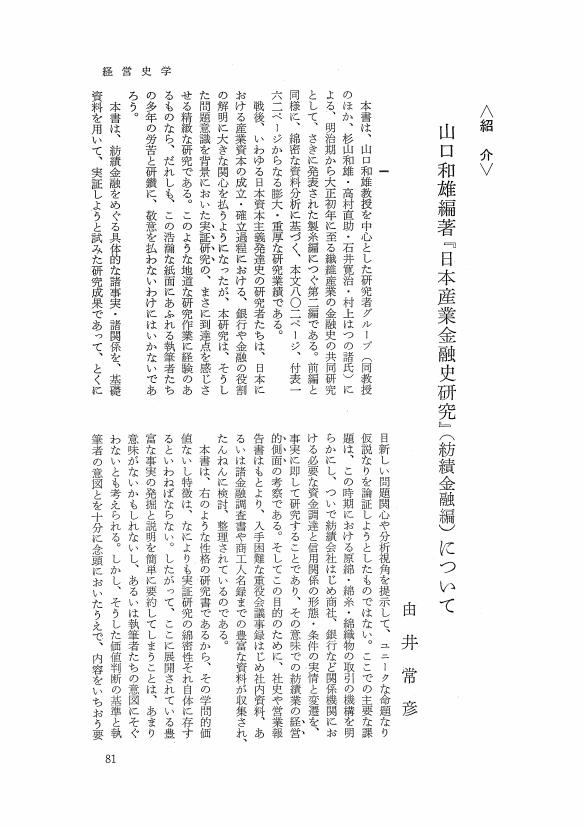5 0 0 0 OA 江戸時代の価値体系とビジネス 明治期の工業化との関連において
- 著者
- 由井 常彦 ヨハネス ヒルシュマイア
- 出版者
- 経営史学会
- 雑誌
- 経営史学 (ISSN:03869113)
- 巻号頁・発行日
- vol.10, no.1, pp.34-51, 1975-08-25 (Released:2009-11-06)
2 0 0 0 マイクロフィルム版営業報告書集成 : 解説・収録書総目録
1 0 0 0 OA 安田商店の経営と資本蓄積
- 著者
- 由井 常彦
- 出版者
- 経営史学会
- 雑誌
- 経営史学 (ISSN:03869113)
- 巻号頁・発行日
- vol.20, no.1, pp.1-35,i, 1985-04-30 (Released:2009-11-06)
It is well known that Yasuda Zenjiro, founder of the Yasuda Zaibatsu, obtained a large amount of money from the Yasuda Shoten (Yasuda & Co.) during the early Meiji period, and this served as a first step in the formation of the fourth largest zaibatsu business combine. Neverthless, the business activities of the early Yasudas' enterprise as well as the process of capital accumulation have not been studied by any economic or business historians. Such a common assertion as “Yasuda built up a great fortune by speculation in Dajokan bills” does not seem to be verifiable.Based on the analysis of original records of the Yasuda Shoten, including accounting books, the main parts of this paper will clarify the nature of a wide variety of the business activities of Yasuda, such as real estate, retail selling of dry goods and banking, and examine the process of capital accumulation in the Yasuda businesses in detail.
1 0 0 0 OA 日本経営史における最大工業企業二〇〇社
- 著者
- 由井 常彦 マーク フルーエン
- 出版者
- 経営史学会
- 雑誌
- 経営史学 (ISSN:03869113)
- 巻号頁・発行日
- vol.18, no.1, pp.29-57,ii, 1983-04-30 (Released:2009-11-06)
- 被引用文献数
- 1
The lists presented here are the data showing the financial records of the 200 largest enterprises in the development of Japanese business. These lists rank large industrial enterprises in the order of the size of the firm and also provide information on the amount of assets, paid-up capital and revenue of each of the enterprises.As the main purpose of this survey is a comparative study among industrialized countries, the lists are devised to the extent possible to be adaptable to international standards. (1) The enterprises listed are the 200 largest industrial enterprises, in accordance with the list of the United States and United Kingdom. (2) The authors researched the year 1918, 1930 and 1954. Although the data for the U.S. and the U.K. includes a list for 1949, marking the beginning of the post World War II period, the authors analyzing Japanese enterprises listed the 200 industrial firms of 1954 instead of 1949, because in 1949 Japanese large enterprises had not yet recovered from the war damage. (3) The standard for ranking enterprises in the lists is the sum of assets in real terms, mainly because most of the Japanese companies before World War II had not published their sales figures. (4) The definition and classification of “industry” is based on the SIC (Standard Classification of Industry) in the U.S.
1 0 0 0 OA 明治時代における重役組織の形成
- 著者
- 由井 常彦
- 出版者
- 経営史学会
- 雑誌
- 経営史学 (ISSN:03869113)
- 巻号頁・発行日
- vol.14, no.1, pp.1-27,i, 1979-09-25 (Released:2009-11-06)
- 被引用文献数
- 1 1
The study of organizational structures from the historical perspective has fallen out of favor in the academic world. In Japan, historical studies of organizations seem to be neglected, except with regard to control of management. This is because historians so far have been inclined to describe industrialization or economic modernization exclusively in terms of capitalist development. However, in view of the importance of the organizational structure in any discussion of economic development, we should address ourselves here to the same problem and ask why Japanese businesses evolved the characteristic and elaborate organization for which they are well known.In my opinion, Japanese top management has had unique organizational traits, summarized in the following three aspects: combination or fusion of managing and control positions, hierachical rank order, and restriction of membership to those with middle-level managerial experience.In this paper I will analyze in detail how this kind of organization had been devised and developed on a trial and error basis in the Meiji Era.
1 0 0 0 OA 山口和雄編著『日本産業金融史研究』(紡績金融編)について
- 著者
- 由井 常彦
- 出版者
- 経営史学会
- 雑誌
- 経営史学 (ISSN:03869113)
- 巻号頁・発行日
- vol.5, no.3, pp.81-86, 1971-08-25 (Released:2010-11-18)
1 0 0 0 OA 海上保険業の創業と確立 東京海上保険会社の場合
- 著者
- 由井 常彦
- 出版者
- 経営史学会
- 雑誌
- 経営史学 (ISSN:03869113)
- 巻号頁・発行日
- vol.3, no.1, pp.54-66, 1968-03-15 (Released:2009-11-11)
1 0 0 0 OA ヒルシュマイア『明治日本の企業者精神について』
- 著者
- 由井 常彦
- 出版者
- 経営史学会
- 雑誌
- 経営史学 (ISSN:03869113)
- 巻号頁・発行日
- vol.1, no.2, pp.88-106, 1966-09-30 (Released:2009-11-11)
1 0 0 0 OA 「文化構造」と経営史 コメント/討論
- 著者
- 由井 常彦
- 出版者
- 経営史学会
- 雑誌
- 経営史学 (ISSN:03869113)
- 巻号頁・発行日
- vol.1, no.1, pp.25-31, 1966-06-20 (Released:2009-11-11)
- 被引用文献数
- 1
- 著者
- 由井 常彦 島田 昌和 佐々木 聡 高橋 清美 松本 和明
- 出版者
- 文京学院大学総合研究所
- 雑誌
- 経営論集 = Business review, Faculty of Business Administration, Bunkyo Gakuin University (ISSN:09169865)
- 巻号頁・発行日
- vol.29, no.1, pp.1-18, 2019-12
- 著者
- 由井 常彦
- 出版者
- 企業史料協議会
- 雑誌
- 企業と史料 (ISSN:09123849)
- 巻号頁・発行日
- vol.15, pp.34-39, 2020-05
- 著者
- 渋沢 栄一 由井 常彦
- 出版者
- ダイヤモンド社
- 雑誌
- Diamondハーバード・ビジネス・レビュー
- 巻号頁・発行日
- vol.34, no.10, pp.50-65, 2009-10





